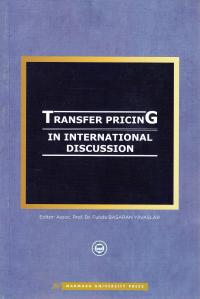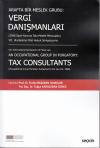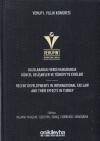
Ed: Assoc.Prof. Dr. Funda BAŞARAN YAVAŞLAR
This book as an example of international cooperation aims', first, to present important points of issue involving both theory and application, and second, to examine comprehesively some problems specific to transfer pricing. The first chapter of the book has a mainly juricidal perspective, examining transfer pricing, the function of hidden profit distribution, legal characteristics and issues, and transfer pricing systems, considering their application in Japan, Germany, Luxemburg and Turkey. İn the second chapter of the book, important subjects of transfer pricing such as transfer prices for intangible property, documentation ments, legal protection of taxpayer, audit methods, databases, and APAs are discussed in detail from a critical perspective. Each section is written by a different outstanding scholarprofessional from Germany, Japan, Luxemburg and Turkey.
TABLE OF CONTENTS
Table of Contents 1
Abbreviations 13
Opening Statements 17
FIRST CHAPTER System of Transfer Pricing
Understanding of the Institution of “Transfer Pricing” 25
Prof. Dr. Mustafa AKKAYA Tl
Disguised Profit Distribution through Transfer Pricing - Function, Legal Characteristics, Issues 27
- I. Introduction 27
- II. “Arm’s Length” Principle 28
- II. Scope of the Principle and Issues 28
- II. Arm’s Length Principle as an Conclusive Presumption 31
- II. Applicabilty of Article 3 of The Tax Procedural Code in Transfer Pricing 32
- III. Povvers Assigned to Council of Ministers and Ministry of Finance 34
- III. Povvers Assigned to Council of Ministers 34
- III. Povver Assigned to Ministry of Finance 34
- IV. Conclusion 34
Regulations Concerning Transfer Pricing and Their Applications in International Comparison 37
Prof. Norihisa YOSHIMURA 39
Transfer Pricing in Japan: An Overvievv 39
- I. Introduction 39
- II. Basic Structures of the Japanese Law and Administration 40
- III. Foreign-associated Corporations 41
- IV. Transfer Pricing Methods and Their Problems 42
- IV. Transfer Pricing Methods 42
- IV. Application of Transfer Pricing Methods 43
- IV. Arm’s Length Rage 43
- V. Compliance Practices 44
- V. Documentation 44
- V. Special Obligations 44
- V. Secret Comparables 45
- VI. APAs 46
- VII. Mutual Agreements and Arbitration 47
- VIII. Conclusion 48
Dr. Stephan RASCH 49
Transfer Pricing in Germany 49
- A. Introduction 49
- B. IncomeAdjustment Clauses - The Arm’s Length Principle in GermanTax Law 50
- B. Hidden Profıt Distribution According to Sentence 2 of Sec. 8 (3) of the Corporation Tax Code 50
- B. Hidden Capital Contribution 53
- B. Sec. 1 of the Foreign Tax Code 54
- C. Methods of Establishing Arm’s Length Prices 55
- C. Introduction 55
- C. Resale Price Method 55
- I. Cost-Plus Method 57
- II. Profit-Split Method 58
- III. Transactional Net Margin Method 60
- IV. Comparable Profıt Method 62
- A. Business Restructuring 62
- A. General Introduction 62
- A. Introduction to German Law on Business Relocation 63
- A. Compliance with International Principles 64
- A. Analysis of Decree-law 65
- A. Defınition, Sec. 1 Decree-law 65
- A. “Negative List”, Sec. 1 Para. 7 Decree-law 68
- A. Provision on Application of Transfer Package, Sec. 2 Decree-law 70
- A. Determination of Value of Transfer Package, Sec. 3-6 Decree-law 70
- A. Calculation of Range of Acceptance, Sec. 7 Decree-law 71
- A. Damage and Compensation Claims, Sec. 8 Decree-law 73
- A. Possibilities of Subsequent Adjustment, Sec. 9 -11 Decree-law 73
- B. Documentation Requirements 74
- B. Introduction 74
- B. Analysis 75
- B. Three Types of Data 75
- B. Acceptance of Profıt-Based Methods 76
- B. Data from Related Parties 77
- B. Best Method Rule 78
- B. Transfer Pricing Guidelines 78
- B. Contemporaneous Documentation 79
- B. Materially Unusable Documentation 80
- B. Extraordinary Transactions 80
- B. Language 81
- B. Mandatory Documents 82
- B. APAs, Unilateral Rulings 83
- B. Cost Allocation Agreements 83
- I. Small Taxpayers 85
- II. Requestfor Documentation 85
5.3. Conclusion 86
Peter MOONS/ Cecile HENLE 87
Regulations in Relation to Transfer Pricing and Their Application in Luxembourg 87
- A. Legal Framevvork 87
- A. Transfer Pricing Adjustments 87
- A. Hidden Dividend Distributions 88
- A. Hidden Capital Contributions 89
- A. Substance Över Form 89
- A. Formal Requirements 89
- B. Administrative Application by Tax Authorities 90
- C. The Intra-group Financing Circular 90
- C. Background 90
- C. The Arm’s Length Principle as Adopted by the OECD 91
- C. Substance Requirements 93
- C. Board Composition 93
- C. ûualifications and Povvers of Board Members 94
- C. Oualified Personnel 94
- C. Key Decisions 94
- C. Bank Account 95
- C. Tax Compliance 95
- C. Exclusion of Dual-resident Entities 95
- C. Equity at Risk 95
3.4. APA Procedure 96
- D. Binding Effect of the Circular and APAs 96
- D. Binding Effect of the Circular 96
- D. Binding Effect of APAs 98
- E. Conclusion 98
Dr. Namık Kemal UYANIK 99
Turkish Transfer Pricing Regulations 99
' Introduction 99
2. Tax Regulations Concerning Hidden Profit Distribution by Transfer Pricing 101
- I. İn General 101
- II. Corporate Tax Law 103
- III. Personal Tax Law 105
3 Statement of Purpose and Scope of Transfer Pricing Regulations and the Arm’s Lenght Principle 106
- III. Statement of Purpose and Scope of Transfer Pricing Regulations 106
- III. Turkish Transfer Pricing Regulations and the Arm’s Length Principle 107
- A. Concept of Related Party 109
- B. Comparability Analysis and the Arm’s Length Methods 110
- B. Comparable Uncontrolled Price (the CUP) 111
- B. Resale Price Method (the RPM) 111
- B. Cost-Plus Method (the CPM) 112
- B. Profit Split Method (the PSM) 113
- B. Transactional Net Margin Method (the TNMM) 114
- C. Transfer Pricing and Loss of Tax Revenue to the National Treasury 115
- D. Intangibles 116
- E. Cost Contribution Agreements 117
- F. Intra-Group Services 117
- G. Transfer Pricing And Documentation 118
- H. Special Taxation Regime 122
İ. Special Sanctions And Special Penalty Sistem 124
- J. Advance Pricing Agreements 125
- J. General Information on Advance Pricing Agreements 125
- J. Regulations Regarding Advance Pricing Agreements 125
SECOND CHAPTER Special Issues of Transfer Pricing and Suggestions for their Solution
A special Problem and Suggestions for its Solution regarding the Determining of the Arm’s-length Price 131
Dr. Xaver DITZ 133
Transfer Prices for Intangible Property 133
- I. Importance of Intangible Property 133
- II. Transfer of Rights to Use Intangible Property 133
- II. Principle 133
- II. Amount 134
- II. Determining Factors 134
- II. Traditional Approaches 135
- II. Transactional Profit Approaches 136
- II. Transfer of Intangible Property 136
- II. Preliminary Remark 136
- II. Appropriate Transfer Prices 137
- III. Conclusions 138
Special Problems and Suggestions for their Solutions Regarding the Taxpayers. 139
Prof. Dr. Nurettin BİLİCİ 141
Types of Legal Protection Against Transfer Pricing Adjustment and the Problem of Proof 141
- A. Introduction 141
- B. Preliminary Information 142
- B. Regulations on Transfer Pricing 142
- B. Some Concepts about Transfer Pricing 143
- B. Formal Obligations about Transfer Pricing 144
2.3.1. Filling in a“Transfer Pricing Form" and submitting it as an Attachment to the Tax Declaration (for ali payers of Corporate Tax) 144
- I. Preparation of “Transfer Pricing Report” (forsome payers of corporate tax) 144
- II. Keeping Data and Documents about Transactions with Related Parties (for payers of Corporate Tax and Income Tax) 145
- A. The Transfer Pricing Issue and Customs Legislation 146
- B. Transfer Pricing During Sale and Rent of Immaterial Economic Values (Copyright, Brand, Patent, and Softvvare Programs) 147
- C. Gain Distribution via Transfer Pricing 147
- A. Corporate Tax Law Regulation 147
- B. Income Tax Law Regulation 148
- B. Exposure to Taxation and Adjustment 148
- B. Treasury Deficit 149
- B. Taxpayers and Cash Pricing (for payers of Corporate Tax) 149
- 1. Solution in Case of a Problem (Transfer Pricing Adjustment) and Burden Of Proof 150
- 1. When does the Administration conduct a Transfer Pricing Inspection? 150
- 1. The Meaning of Transfer Pricing Adjustment and Sanctions 150
- 1. Administrative Solution for Transfer Pricing Adjustment 151
- 1. Resorting to Jurisdiction because of Transfer Pricing Adjustment and Proof 151
- 1. Does the Burden of Proof belong to the Taxpayer orTax Administration? 152
- 1. “Secret Precedent” as a Means of Proof? 154
- 1. Taxpayer’s Defense of Applied Price: Defense of Related Party Transaction Price’s Conformity to Art. 13/4 Corporate Tax Law 154
- 1. “Comparable Price Method” has been applied 154
- 1. Transaction concerns Intragroup Production and Distribution Process 155
- 1. The Price According to the “Resale Price Method” 155
- 1. A Special Method has been Applied for the Determination of the Price 155
- 1. Reasons why the Related Party Price Differs from the Price Determined by the Administration 155
- 2. Additional Solutions When Transfer Pricing Process Has International Dimensions 157
4.1. Regulations on Conventions to Prevent Double Taxation 158
- I. One can benefit from Mutual Consent Method (MCM) due to Double Taxation Agreements 158
- II. The Problem May be Solved through Arbitration 159
- III. Solutions Concerning Transfer Pricing on the Example of EU (Arbitration Convention) 159
- A. Preliminary Information 159
- B. Taxation has been conducted on Transfer Pricing in a Member State 160
- C. Related other Country Does Not Accept Adjustment 160
- D. If Administrations and Taxpayer Do Not Agree vvithin MCM Process, the Arbitration Process begins 160
5. Conclusion 161
Prof. Dr. Roman SEER 165
Transfer Pricing Documentation with Affiliated Companies - Necessity of Limiting Obligations 165
- A. Introduction 165
- B. Obligatory Content of Transfer Pricing Documentation 166
- C. Demand for Submission as a Measure of Field Audit 169
- D. Legal Function of Evidence Rules for Documentation 170
- E. Legal Consequences ofViolating Documentation Obligations 171
- E. Reducing the Standard of Evidence to the Detriment of the Tax Payer 171
- E. “Penalty Surcharge” pursuant to Sec. 162 Para. 4 GTC 173
- F. Conclusion 175
Special Problems and Suggestions for their Solutions Regarding the Tax Administration 177
Adnan ERTÜRK/Muhittin ESEN 179
Audit Methods and Use of Databases in Transfer Pricing 179
- 1. Introduction 179
- 2. Transfer Pricing Compliance Practices in OECD Guideliness 179
- I. Legislation and Administrative Procedures 179
- II. Aspects of Transfer Pricing Compliance That Should Receive Special Consideration by Tax Administrations 179
- A. Examination Practices 180
- B. Burden of Proof 180
- C. Penalties 181
- A. Tax Loss Result from Transfer Pricing and The Importance of Transfer Pricing Examinations 182
- A. The Importance of Transfer Pricing Examinations 182
- A. Approximate Tax Loss Arising From Transfer Pricing in the VVorld and in Turkey 184
- B. Selecting the Right Cases for Transfer Pricing Audits 185
- B. Risk Identification 187
- B. Information Sources for Risk Identification 187
- B. Tax Returns, Accounts, Transfer Pricing Documentation and ûuestionnaires 187
- B. Third Parties 187
- B. Risk Indicators for Transfer Pricing 188
- B. Selecting Transfer Pricing Cases in Turkey 191
- B. Extending Risk Factors Identified in Routine Audits to Other Firms Operating in the Same Sector 191
- B. The Use of Tax Returns, Financial Statements and Transfer Pricing Forms 191
- B. Information from other Government Agencies 192
- B. Different Country Examples with Respect to the Selection Criteria for Cases 192
- B. United Kingdom 192
- B. China 193
- B. Conducting Transfer Pricing Audits in Turkey 193
- B. Some Suggestions to Increase the Efficiency of Transfer Pricing Audits 194
4.5.1. An Efficient Risk Analysis System 194
- I. The Importance of the Number of Comparable Firms 194
- II. The Use of Mathematical Models to Determine Arm’s Length Price 194
- III. Exchange of Information 194
- IV. Specialization of Tax Auditors 195
5. Determination of External Comparables through Databases 195
- IV. Difficulties in Determining External Comparables 195
- IV. External Comparables and Databases According to OECD Guidelines 196
- IV. International Databases 197
- IV. Databases According to Turkish Tax Legislation 198
- IV. The Advantages of Databases 198
- IV. Taxpayers will have Access to Numerous External Comparables 199
- IV. Databases will Allovv Mathematical Analysis 199
- IV. Databases will Provide the Information That is Unavailable in Financial Statements 199
Assoc. Prof. Dr. Funda BAŞARAN YAVAŞLAR 201
Advance Pricing Arrangements and the Constitutional Limits on these Arrangements 201
- A. Defınition, Justification and Legal Basis of APAs 201
- B. The Legal Nature of APAs 205
- C. Main Subject of APAs According to Turkish Law: A transfer pricing method which complies with the arm’s length principle 209
- C. The Basic Objective in Determining the Applicable Method: Being applicable for the determination of the arm’s length price or the value 209
- C. The Scope of Transactions VVhich Are Related to the Method 211
- D. Procedure of Making APAs 212
- D. Application 212
- D. Persons Eligible to Apply for an APA 212
- D. Application Form and Content 213
- D. Paymentof Application Fee 215
4.2. Evaluation of Application and Reply 216
- I. Acceptance of Application and the Signing of an APA
- II. Legal Consequences of APAs and Their Implementations
- A. Amendment, Renevval and Cancellation of APAs
- B. The Unconstitutionality Issue of APAs
Subject lndex
Bibliography
Ed: Assoc.Prof. Dr. Funda BAŞARAN YAVAŞLAR
This book as an example of international cooperation aims', first, to present important points of issue involving both theory and application, and second, to examine comprehesively some problems specific to transfer pricing. The first chapter of the book has a mainly juricidal perspective, examining transfer pricing, the function of hidden profit distribution, legal characteristics and issues, and transfer pricing systems, considering their application in Japan, Germany, Luxemburg and Turkey. İn the second chapter of the book, important subjects of transfer pricing such as transfer prices for intangible property, documentation ments, legal protection of taxpayer, audit methods, databases, and APAs are discussed in detail from a critical perspective. Each section is written by a different outstanding scholarprofessional from Germany, Japan, Luxemburg and Turkey.
TABLE OF CONTENTS
Table of Contents 1
Abbreviations 13
Opening Statements 17
FIRST CHAPTER System of Transfer Pricing
Understanding of the Institution of “Transfer Pricing” 25
Prof. Dr. Mustafa AKKAYA Tl
Disguised Profit Distribution through Transfer Pricing - Function, Legal Characteristics, Issues 27
- I. Introduction 27
- II. “Arm’s Length” Principle 28
- II. Scope of the Principle and Issues 28
- II. Arm’s Length Principle as an Conclusive Presumption 31
- II. Applicabilty of Article 3 of The Tax Procedural Code in Transfer Pricing 32
- III. Povvers Assigned to Council of Ministers and Ministry of Finance 34
- III. Povvers Assigned to Council of Ministers 34
- III. Povver Assigned to Ministry of Finance 34
- IV. Conclusion 34
Regulations Concerning Transfer Pricing and Their Applications in International Comparison 37
Prof. Norihisa YOSHIMURA 39
Transfer Pricing in Japan: An Overvievv 39
- I. Introduction 39
- II. Basic Structures of the Japanese Law and Administration 40
- III. Foreign-associated Corporations 41
- IV. Transfer Pricing Methods and Their Problems 42
- IV. Transfer Pricing Methods 42
- IV. Application of Transfer Pricing Methods 43
- IV. Arm’s Length Rage 43
- V. Compliance Practices 44
- V. Documentation 44
- V. Special Obligations 44
- V. Secret Comparables 45
- VI. APAs 46
- VII. Mutual Agreements and Arbitration 47
- VIII. Conclusion 48
Dr. Stephan RASCH 49
Transfer Pricing in Germany 49
- A. Introduction 49
- B. IncomeAdjustment Clauses - The Arm’s Length Principle in GermanTax Law 50
- B. Hidden Profıt Distribution According to Sentence 2 of Sec. 8 (3) of the Corporation Tax Code 50
- B. Hidden Capital Contribution 53
- B. Sec. 1 of the Foreign Tax Code 54
- C. Methods of Establishing Arm’s Length Prices 55
- C. Introduction 55
- C. Resale Price Method 55
- I. Cost-Plus Method 57
- II. Profit-Split Method 58
- III. Transactional Net Margin Method 60
- IV. Comparable Profıt Method 62
- A. Business Restructuring 62
- A. General Introduction 62
- A. Introduction to German Law on Business Relocation 63
- A. Compliance with International Principles 64
- A. Analysis of Decree-law 65
- A. Defınition, Sec. 1 Decree-law 65
- A. “Negative List”, Sec. 1 Para. 7 Decree-law 68
- A. Provision on Application of Transfer Package, Sec. 2 Decree-law 70
- A. Determination of Value of Transfer Package, Sec. 3-6 Decree-law 70
- A. Calculation of Range of Acceptance, Sec. 7 Decree-law 71
- A. Damage and Compensation Claims, Sec. 8 Decree-law 73
- A. Possibilities of Subsequent Adjustment, Sec. 9 -11 Decree-law 73
- B. Documentation Requirements 74
- B. Introduction 74
- B. Analysis 75
- B. Three Types of Data 75
- B. Acceptance of Profıt-Based Methods 76
- B. Data from Related Parties 77
- B. Best Method Rule 78
- B. Transfer Pricing Guidelines 78
- B. Contemporaneous Documentation 79
- B. Materially Unusable Documentation 80
- B. Extraordinary Transactions 80
- B. Language 81
- B. Mandatory Documents 82
- B. APAs, Unilateral Rulings 83
- B. Cost Allocation Agreements 83
- I. Small Taxpayers 85
- II. Requestfor Documentation 85
5.3. Conclusion 86
Peter MOONS/ Cecile HENLE 87
Regulations in Relation to Transfer Pricing and Their Application in Luxembourg 87
- A. Legal Framevvork 87
- A. Transfer Pricing Adjustments 87
- A. Hidden Dividend Distributions 88
- A. Hidden Capital Contributions 89
- A. Substance Över Form 89
- A. Formal Requirements 89
- B. Administrative Application by Tax Authorities 90
- C. The Intra-group Financing Circular 90
- C. Background 90
- C. The Arm’s Length Principle as Adopted by the OECD 91
- C. Substance Requirements 93
- C. Board Composition 93
- C. ûualifications and Povvers of Board Members 94
- C. Oualified Personnel 94
- C. Key Decisions 94
- C. Bank Account 95
- C. Tax Compliance 95
- C. Exclusion of Dual-resident Entities 95
- C. Equity at Risk 95
3.4. APA Procedure 96
- D. Binding Effect of the Circular and APAs 96
- D. Binding Effect of the Circular 96
- D. Binding Effect of APAs 98
- E. Conclusion 98
Dr. Namık Kemal UYANIK 99
Turkish Transfer Pricing Regulations 99
' Introduction 99
2. Tax Regulations Concerning Hidden Profit Distribution by Transfer Pricing 101
- I. İn General 101
- II. Corporate Tax Law 103
- III. Personal Tax Law 105
3 Statement of Purpose and Scope of Transfer Pricing Regulations and the Arm’s Lenght Principle 106
- III. Statement of Purpose and Scope of Transfer Pricing Regulations 106
- III. Turkish Transfer Pricing Regulations and the Arm’s Length Principle 107
- A. Concept of Related Party 109
- B. Comparability Analysis and the Arm’s Length Methods 110
- B. Comparable Uncontrolled Price (the CUP) 111
- B. Resale Price Method (the RPM) 111
- B. Cost-Plus Method (the CPM) 112
- B. Profit Split Method (the PSM) 113
- B. Transactional Net Margin Method (the TNMM) 114
- C. Transfer Pricing and Loss of Tax Revenue to the National Treasury 115
- D. Intangibles 116
- E. Cost Contribution Agreements 117
- F. Intra-Group Services 117
- G. Transfer Pricing And Documentation 118
- H. Special Taxation Regime 122
İ. Special Sanctions And Special Penalty Sistem 124
- J. Advance Pricing Agreements 125
- J. General Information on Advance Pricing Agreements 125
- J. Regulations Regarding Advance Pricing Agreements 125
SECOND CHAPTER Special Issues of Transfer Pricing and Suggestions for their Solution
A special Problem and Suggestions for its Solution regarding the Determining of the Arm’s-length Price 131
Dr. Xaver DITZ 133
Transfer Prices for Intangible Property 133
- I. Importance of Intangible Property 133
- II. Transfer of Rights to Use Intangible Property 133
- II. Principle 133
- II. Amount 134
- II. Determining Factors 134
- II. Traditional Approaches 135
- II. Transactional Profit Approaches 136
- II. Transfer of Intangible Property 136
- II. Preliminary Remark 136
- II. Appropriate Transfer Prices 137
- III. Conclusions 138
Special Problems and Suggestions for their Solutions Regarding the Taxpayers. 139
Prof. Dr. Nurettin BİLİCİ 141
Types of Legal Protection Against Transfer Pricing Adjustment and the Problem of Proof 141
- A. Introduction 141
- B. Preliminary Information 142
- B. Regulations on Transfer Pricing 142
- B. Some Concepts about Transfer Pricing 143
- B. Formal Obligations about Transfer Pricing 144
2.3.1. Filling in a“Transfer Pricing Form" and submitting it as an Attachment to the Tax Declaration (for ali payers of Corporate Tax) 144
- I. Preparation of “Transfer Pricing Report” (forsome payers of corporate tax) 144
- II. Keeping Data and Documents about Transactions with Related Parties (for payers of Corporate Tax and Income Tax) 145
- A. The Transfer Pricing Issue and Customs Legislation 146
- B. Transfer Pricing During Sale and Rent of Immaterial Economic Values (Copyright, Brand, Patent, and Softvvare Programs) 147
- C. Gain Distribution via Transfer Pricing 147
- A. Corporate Tax Law Regulation 147
- B. Income Tax Law Regulation 148
- B. Exposure to Taxation and Adjustment 148
- B. Treasury Deficit 149
- B. Taxpayers and Cash Pricing (for payers of Corporate Tax) 149
- 1. Solution in Case of a Problem (Transfer Pricing Adjustment) and Burden Of Proof 150
- 1. When does the Administration conduct a Transfer Pricing Inspection? 150
- 1. The Meaning of Transfer Pricing Adjustment and Sanctions 150
- 1. Administrative Solution for Transfer Pricing Adjustment 151
- 1. Resorting to Jurisdiction because of Transfer Pricing Adjustment and Proof 151
- 1. Does the Burden of Proof belong to the Taxpayer orTax Administration? 152
- 1. “Secret Precedent” as a Means of Proof? 154
- 1. Taxpayer’s Defense of Applied Price: Defense of Related Party Transaction Price’s Conformity to Art. 13/4 Corporate Tax Law 154
- 1. “Comparable Price Method” has been applied 154
- 1. Transaction concerns Intragroup Production and Distribution Process 155
- 1. The Price According to the “Resale Price Method” 155
- 1. A Special Method has been Applied for the Determination of the Price 155
- 1. Reasons why the Related Party Price Differs from the Price Determined by the Administration 155
- 2. Additional Solutions When Transfer Pricing Process Has International Dimensions 157
4.1. Regulations on Conventions to Prevent Double Taxation 158
- I. One can benefit from Mutual Consent Method (MCM) due to Double Taxation Agreements 158
- II. The Problem May be Solved through Arbitration 159
- III. Solutions Concerning Transfer Pricing on the Example of EU (Arbitration Convention) 159
- A. Preliminary Information 159
- B. Taxation has been conducted on Transfer Pricing in a Member State 160
- C. Related other Country Does Not Accept Adjustment 160
- D. If Administrations and Taxpayer Do Not Agree vvithin MCM Process, the Arbitration Process begins 160
5. Conclusion 161
Prof. Dr. Roman SEER 165
Transfer Pricing Documentation with Affiliated Companies - Necessity of Limiting Obligations 165
- A. Introduction 165
- B. Obligatory Content of Transfer Pricing Documentation 166
- C. Demand for Submission as a Measure of Field Audit 169
- D. Legal Function of Evidence Rules for Documentation 170
- E. Legal Consequences ofViolating Documentation Obligations 171
- E. Reducing the Standard of Evidence to the Detriment of the Tax Payer 171
- E. “Penalty Surcharge” pursuant to Sec. 162 Para. 4 GTC 173
- F. Conclusion 175
Special Problems and Suggestions for their Solutions Regarding the Tax Administration 177
Adnan ERTÜRK/Muhittin ESEN 179
Audit Methods and Use of Databases in Transfer Pricing 179
- 1. Introduction 179
- 2. Transfer Pricing Compliance Practices in OECD Guideliness 179
- I. Legislation and Administrative Procedures 179
- II. Aspects of Transfer Pricing Compliance That Should Receive Special Consideration by Tax Administrations 179
- A. Examination Practices 180
- B. Burden of Proof 180
- C. Penalties 181
- A. Tax Loss Result from Transfer Pricing and The Importance of Transfer Pricing Examinations 182
- A. The Importance of Transfer Pricing Examinations 182
- A. Approximate Tax Loss Arising From Transfer Pricing in the VVorld and in Turkey 184
- B. Selecting the Right Cases for Transfer Pricing Audits 185
- B. Risk Identification 187
- B. Information Sources for Risk Identification 187
- B. Tax Returns, Accounts, Transfer Pricing Documentation and ûuestionnaires 187
- B. Third Parties 187
- B. Risk Indicators for Transfer Pricing 188
- B. Selecting Transfer Pricing Cases in Turkey 191
- B. Extending Risk Factors Identified in Routine Audits to Other Firms Operating in the Same Sector 191
- B. The Use of Tax Returns, Financial Statements and Transfer Pricing Forms 191
- B. Information from other Government Agencies 192
- B. Different Country Examples with Respect to the Selection Criteria for Cases 192
- B. United Kingdom 192
- B. China 193
- B. Conducting Transfer Pricing Audits in Turkey 193
- B. Some Suggestions to Increase the Efficiency of Transfer Pricing Audits 194
4.5.1. An Efficient Risk Analysis System 194
- I. The Importance of the Number of Comparable Firms 194
- II. The Use of Mathematical Models to Determine Arm’s Length Price 194
- III. Exchange of Information 194
- IV. Specialization of Tax Auditors 195
5. Determination of External Comparables through Databases 195
- IV. Difficulties in Determining External Comparables 195
- IV. External Comparables and Databases According to OECD Guidelines 196
- IV. International Databases 197
- IV. Databases According to Turkish Tax Legislation 198
- IV. The Advantages of Databases 198
- IV. Taxpayers will have Access to Numerous External Comparables 199
- IV. Databases will Allovv Mathematical Analysis 199
- IV. Databases will Provide the Information That is Unavailable in Financial Statements 199
Assoc. Prof. Dr. Funda BAŞARAN YAVAŞLAR 201
Advance Pricing Arrangements and the Constitutional Limits on these Arrangements 201
- A. Defınition, Justification and Legal Basis of APAs 201
- B. The Legal Nature of APAs 205
- C. Main Subject of APAs According to Turkish Law: A transfer pricing method which complies with the arm’s length principle 209
- C. The Basic Objective in Determining the Applicable Method: Being applicable for the determination of the arm’s length price or the value 209
- C. The Scope of Transactions VVhich Are Related to the Method 211
- D. Procedure of Making APAs 212
- D. Application 212
- D. Persons Eligible to Apply for an APA 212
- D. Application Form and Content 213
- D. Paymentof Application Fee 215
4.2. Evaluation of Application and Reply 216
- I. Acceptance of Application and the Signing of an APA
- II. Legal Consequences of APAs and Their Implementations
- A. Amendment, Renevval and Cancellation of APAs
- B. The Unconstitutionality Issue of APAs
Subject lndex
Bibliography













